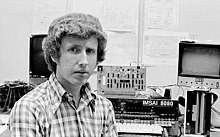Hayes Microcomputer Products
Hayes Microcomputer Products was an American manufacturer of modems and known for its smart modem . Dennis Hayes and Dale Heatherington founded the company in Norcross, Georgia in 1977 and launched the first modems for home computers and personal computers. The AT command set they developed for modem control became an industry standard that is still used today. Hayes was a well-known brand through the 1980s and 1990s , and the company's modems were known for their reliability and compatibility. In its prime, the company had a market share of over 50%, and computer magazines advised their readers to only buy modems that supported the AT command set . The decline began when Hayes failed to bring modems with more than 2400 bit / s to the market at the same time as other manufacturers. The company US Robotics filled this gap and also gained the status of a top brand. In addition, other manufacturers undercut Hayes' prices. Hayes tried to gain advantages by buying out competitors such as Practical Peripherals and Cardinal.
Heatherington left the company at the age of 36 and received $ 20 million for his stake in the company.
As modems became more and more mass-produced and profit margins fell, Hayes tried to open up new business areas, but failed. In the mid-1990s, many of the Hayes products only had standard chipsets and had little else to offer to set themselves apart from the competition
In 1998, Hayes had to file for bankruptcy and was liquidated. The brand name was bought by former competitor Zoom in July 1999 .
Smart modem
After the first internal modem cards for S-100 bus computers and the Apple II , Hayes moved the modem to an external housing and used the RS-232 serial connection. This was only possible if the control and data were transferred via a cable. To do this, they created the AT command set.
The first external modem, marketed as the Hayes Stack Smartmodem, hit the market in April 1981 for about $ 279 . The term stack was later discarded and referred to the stackable housing format. Another innovation was the use of a Zilog Z8 microprocessor.
A number of models that support higher transmission speeds followed, but by the mid-1980s there were a number of competing products.
Individual evidence
- ↑ Victoria Shannon: The Rise and Fall of the Modem King. In: International Herald Tribune. January 7, 1999, archived from the original ; accessed on July 30, 2020 (English).
- ↑ Hayes Microcomputer Products, Inc. . In: CW Communications (Ed.): Computerworld . 15, No. 17, April 27, 1981, ISSN 0010-4841 , p. 42.
- ↑ Hayes Smartmodem ad in Personal Computing . February 1982, accessed August 3, 2020 .
- ↑ Retro Thing: Getting Online: The Hayes Smartmodem. In: retrothing.com. Accessed July 30, 2020 (English).
- ↑ Unboxing Hayes Stack Smartmodem and Apple II + on YouTube , November 12, 2017.

